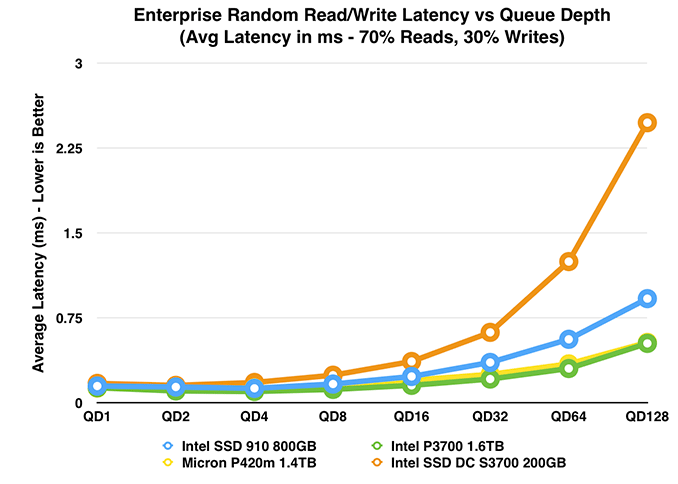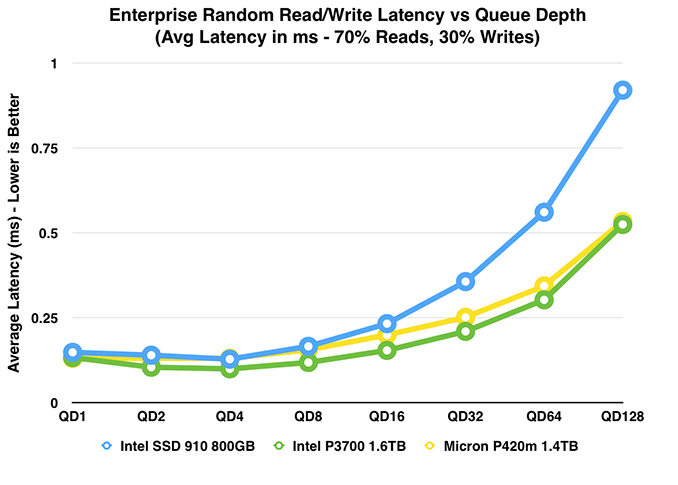Intel SSD DC P3700 Review: The PCIe SSD Transition Begins with NVMe
by Anand Lal Shimpi on June 3, 2014 2:00 AM EST- Posted in
- Storage
- SSDs
- Intel
- Intel SSD DC P3700
- NVMe
Mixed Read/Write Performance
Although our four corner testing is useful, many real world enterprise workloads are composed of a mixture of reads and writes. OLTP environments in particular tend to see a 70/30 split between reads and writes. The test below is conducted the same way as our 4KB random write test (1 sequential drive write, 1 4K-QD128 random drive write, then 3 minute test), but the actual test is 70% reads and 30% writes.

The results here look a lot like the 4KB random read results, but with a slightly different slope. The P3700 and Micron's P420m compete for top billing, but the P3700's superior random write performance and solid midrange queue depth random read performance ultimately give it the edge here.












85 Comments
View All Comments
gospadin - Tuesday, June 3, 2014 - link
tRead on MLC NAND is > 50us. 10us latency will never be achievable with an MLC NAND back-end without a redesign of the NAND array.mavere - Friday, June 6, 2014 - link
"I am angry because my ridiculous fantasies aren't fulfilled."Antronman - Tuesday, June 3, 2014 - link
Fusion iO blows it all away.TelstarTOS - Tuesday, June 3, 2014 - link
did they make it bootable on windows after what 8 years?extide - Tuesday, June 3, 2014 - link
At what cost?I'd definitely like to see some FusionIO benches on this site...
TelstarTOS - Tuesday, June 3, 2014 - link
At last Intel showed its muscles again.If in a 6 month timeframe something similar and cheaper doesnt come out, the 400GB P3600 will be my next SSD. Looking forward SF3700 really curiously now.
Kevin G - Tuesday, June 3, 2014 - link
I love the raw speed that this delivers. It does not hold anything back in terms of performance. I'm genuinely excited as to what a full blown server implementation using 16x PCIe 3.0 could provide.My only issue is one of capacity and cost per GB of storage. It is good to see 2 TB solutions but honestly I was hoping for a bit more. Moving away from the 2.5" SATA, M.2 and mSATA formats should enable far more NAND packages. I can see Intel limiting these consumer/prosumer cards to lower capacities to keep the higher capacity units in the enterprise space where ultra fast storage carries a higher premium. Speaking of costs, I was prepared to accept this as costing a bit more but not this much. Things like moving to an 18 channel design and the cost of the NVMe controller would be more expensive but not quiet this much. I was hoping to see something closer to $1/GB as the 2.5" SATA market is well below that and starting to approach $0.50/GB. Speed can carry a premium but those lower $/GB SATA drives are still pretty fast on their own.
Actually are there any subjective impressions? Does the P3700 feel noticeably faster in day-to-day usage than a generic 2.5" SATA SDD?
I'd also like to see some boot testing. Generally there are some quirks here and there that crop up with technology introductions.
kaix2 - Tuesday, June 3, 2014 - link
with the p3700 drive rated at 10dw/d it's aimed at high end enterprise. expecting $1/GB for this high end of a drive isn't realistic. also it's not a fair comparison if you simply compare the price of this drive to an average consumer sata drive and not take nand endurance and quality into account.Sacco_svd - Tuesday, June 3, 2014 - link
P3700 / 2048gb*3dollar = 6144 dollarsP3500 / 2048gb*1.469dollar = 3061.76 dollars
If those are going to be the prices they're still not competitively cheap, by a big margin.
balindad - Tuesday, June 3, 2014 - link
As mentioned else where, could you drop this in on any open pcie and have it work and bootable with no other upgrades needed as long as you're running windows 8?